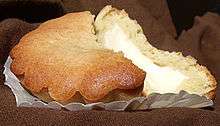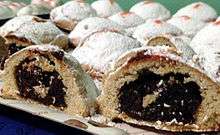Pasticciotto
 Ricotta-filled pasticciotto | |
| Alternative names | Pusties |
|---|---|
| Type | Pastry |
| Place of origin | Italy |
| Region or state | Apulia |
| Created by | Andrea Ascalone |
| Serving temperature | warm |
| Variations | Various fillings |
A pasticciotto (Italian pronunciation: [pa.stiˈttʃiɔt.to], plural: pasticciotti) is a type of filled Italian pastry. Depending on the region, they are traditionally filled with either ricotta cheese or egg custard. In some Italian-American communities, they are called pusties.[1]
Pasticciotti are approximately 1 inch (2.5 cm) thick.[2] They are typically served as a breakfast item, but may also be eaten throughout the day,[3][4] and are a traditional Easter pastry in Sicily.[2] According to a number of sources, pasticciotti should be eaten warm.[3][5]
Composition


Crust
The short-crust pastry dough used to make pasticciotti was originally shortened with lard, but modern recipes may use butter instead, though this alters the texture of the crust.[4][6] An egg wash is often applied to the top of each pastry before baking.
Fillings
Fillings for pasticciotti include the traditional lemon-flavored custard[5] or ricotta,[2] and variant fillings such as almond, chocolate, pistachio or vanilla custard; fruit preserves; or gianduja or Nutella chocolate-hazelnut spreads.[3][4][6] An unusual variation filled with ground veal and almonds but topped with sugar, pasticciotti di carne, is a local favorite in the Sicilian town of Patti.[7] Pasticciotti di carne are similar to the Moroccan pastilla which also combines a meat filling with a sugar topping. In Italy, ricotta-filled pasticciotti are the typical variety in Sicily,[2] while the custard filling is more commonly seen in the Apulia region of southeastern mainland Italy,[6] particularly in the province of Lecce, where the city of Lecce named the pasticciotto its typical cake.[5] In Naples, in southwestern Italy between Apulia and Sicily, custard fillings are common but the pasticiotto napoletano also includes cherries.[8] Both custard and ricotta fillings can be found in the United States.[2][9]
History
The invention of pasticciotti is credited to Andrea Ascalone, a chef in the town of Galatina in Lecce, who in 1745 used ingredients left over from full-sized tortas to create a smaller cake. The name pasticciotto allegedly comes from Ascalone himself regarding his creation as a pasticcio, or "mishap".[4]
Availability
In southern Apulia, pasticciotti are sold in bakeries, bars, coffee shops and restaurants.[5][6] They are also commonly available at Italian-American bakeries in the United States, alongside other Italian pastries like cannoli and sfogliatelle.[10][11]
References
- ↑ D'Imperio, Chuck (Apr 30, 2015). "Pusties". Taste of Upstate New York: The People and the Stories Behind 40 Food Favorites. Syracuse University Press. pp. 65–68. ISBN 9780815653233.
- 1 2 3 4 5 Lombardo, Calogero (2002). Altavilla, Sicily: Memories of a Happy Childhood. Legas Publishing. pp. 147–8. ISBN 978-1-881901-36-5.
- 1 2 3 Massa-Langlois, Grace (2012). Grace's Sweet Life: Homemade Italian Desserts from Cannoli, Tiramisu, and Panna Cotta to Torte, Pizzelle, and Struffoli. Ulysses Press. p. 126. ISBN 978-1-61243-024-9.
- 1 2 3 4 Bieder, Daniela (8 September 2015). "Pasticciotto – well invested calories". Wall Street International. Retrieved 10 October 2015.
- 1 2 3 4 Ersetti, Dario. "Pasticciotto, a delight from Salento". BridgePugliaUSA.it. Retrieved 10 October 2015.
- 1 2 3 4 Socratous, Georgie. "Mini Pasticciotto". Jamie Magazine. Jamie Oliver. Retrieved 10 October 2015.
- ↑ "Patti". PattiTindari.com (in Italian). Retrieved 10 October 2015.
- ↑ Terti, Luca (2014). Le torte più buone – I segreti del pasticciere: Dolci semplici e veloci, come in pasticceria. eCucina. p. 76. ASIN B00NUHITUS.
- ↑ Browne, Rick (2013). A Century of Restaurants: Stories and Recipes from 100 of America's Most Historic and Successful Restaurants. Andrews McMeel Publishing. p. PT641. ISBN 978-1-4494-0783-4.
- ↑ Klimovich Harrop, JoAnne (29 July 2014). "Satisfy your sweet tooth in Pittsburgh with treats from ethnic bakeries". Pittsburgh Tribune-Review. Retrieved 10 October 2015.
- ↑ Backus, Lisa (14 July 2015). "New Berlin bakery serves up Italian treats". New Britain Herald. Retrieved 10 October 2015.